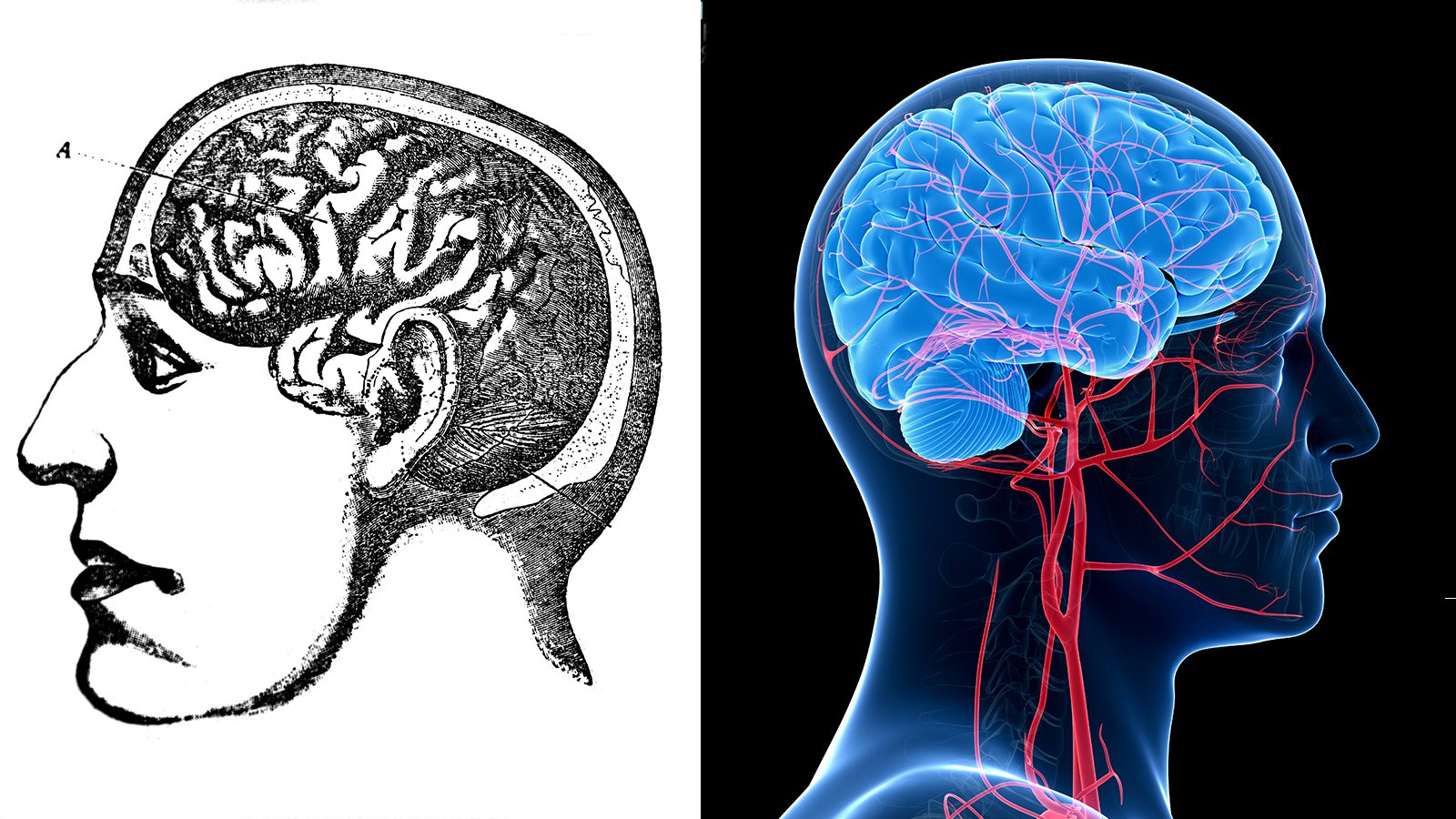Human brains are one of the most complex things ever studied. Even after hundreds of years, scientists still don’t know everything there is to know about the cranium and brain. We know that the human brain is capable of things that no other living being is capable of.
We can communicate through languages, not just sounds, which allows us to create societies that give us many advantages. Even though monkeys and dolphins are brilliant, they can never build what humans built. They don’t have the means to organize and communicate, so they will never come close to recreating our society.
Even though we are the most advanced species, that’s not because of how big the human brain is. It is smaller relative to other species, but it’s getting smaller as time passes. Research done on the topic of cranium fossils reveals that our brains are significantly smaller than our ancestors.
This shows that it’s not the size of the brain that allows us to live in prominent societies and invent incredible things. But why is our brain getting smaller? And does that impact our intellectual abilities in any way?
Understanding The Structure Of The Cranium And Brain
To better understand why the human brain shrunk through time, it’s essential to know how to brain is structured now. Of course, the human brain has gone through multiple evolutionary stages, but right now, it seems to have stabilized. Right now, three main parts compose the brain: the forebrain, the midbrain, and the hindbrain. Each of these parts houses multiple segments. They sit inside the cranium, which you might call the skull.

The Tree Regions of the Brain
The forebrain contains the cerebrum, the most sizeable part of the brain, and other structures like the thalamus and hypothalamus. The cerebrum drives higher brain function and contains four lobes. There are: the frontal lobe, the parietal lobe, the occipital lobe, and the temporal lobe. Each of these structures is responsible for specific functions.
For example, the frontal lobe impacts a human’s ability to reason, speak, organize, move, make facial expressions, etc. The occipital lobe is responsible for visual processing. The parietal lobe controls complex behaviors and senses. It’s also vital for integrating information from the body and knowledge of numbers. And the temporal lobe is responsible for interpreting auditory stimuli.
The midbrain is the region between the thalamus and the pons. It’s composed of the tegmentum, the cerebral peduncles, and colliculi. This structure is the smallest out of the three, and it’s located centrally within the cranial cavity. Its role is to connect the brain with the spinal cord. The colliculi contain neurons that process different signals, such as visual ones.
The tegmentum plays a role in coordinating movements, suppressing pain, and keeping us alert. The peduncles are a pair of large nerve fiber bundles which are highways for signals that move from the cortex to other parts of the CNS.
The hindbrain is in the lower back part of the brain. It’s formed of most of the brainstem and the cerebellum structure. Most of the twelve cranial nerves are found in this region. The pons connects the rest of the brainstem with the cerebral cortex. It acts as a coordinator for signals and communications between the brain hemispheres and the spinal cord.
There are four cranial nerves in this part, each tasked with its own set of responsibilities. Behind this region lies the cerebellum (Latin for “little brain”), which coordinates sensation responses from the muscles. This allows us to make most voluntary movements. It also plays a role in maintaining balance and posture.
Why Is the Human Brain Getting Smaller?
Here are possible reasons why we have a smaller cranium than our ancestors.
1. Increase in BMI
The current literature regarding encephalization in modern humans found that the modern brain is significantly smaller than prehistoric humans. The absolute brain size seems to have declined by 5.4%. However, throughout the past 50,000 years, encephalization levels have remained relatively stable, except for modern humans.
This change makes sense if we look at BMI levels now compared to the past. Scientists argue that the change in brain size is a direct response to changes in human physiology, so it’s an evolutionary change. Indeed, there is a lot of speculation regarding whether brain reduction is a consequence or a cause of weight gain. But the correlation remains undeniable.
Obesity also affects our neurocognitive health. Weight gain has been associated with a reduction in grey matter volume, even in neurologically healthy individuals. Because of this, the whole brain volume shrinks. Of course, this association is not universally true, as it doesn’t always account for other factors, such as diabetes and other issues.
Some studies found a positive association between brain size and a higher BMI, but in those cases, the cause of increased brain size was other issues. But the truth remains that, on average, because modern humans’ BMIs are higher, this leads to a smaller brain size when compared to our ancestors.
The exciting part is that the erosion appears in the grey matter, not the white one. The grey matter is what’s unique to humans, as it contains the cell bodies of neurons that allow us to communicate through languages and writing. This matter accounts for most of our complex behaviors, so it would seem like its reduction would mean a lower IQ. However, there are still many debates regarding this issue, and a consensus seems to elude scientists.

2. Reliance on Collective Intelligence
A drastic decrease in brain size occurred in the past few thousands of years. This fact has long been a mystery for anthropologists, but recent studies seem to have an explanation. One of the most successful studies on this topic was done by a team that compared their findings to the inner workings of ant societies. Their theory stated that humans rely on collective intelligence to function correctly, like ants.
The team analyzed a dataset of 985 cranial fossils and modern crania and found that the brain increased 2.1 million years ago but decreased 3,000 years ago. This finding showed a more recent decrease than what was previously believed. The timing coincides with technical advancements that lead to better diet and nutrition and larger social groups. With these findings in mind, the team studied ant groups to determine whether social life affects any brain size.
They found that, when put in a group, a brain will adapt and specialize in doing the tasks it’s responsible for. This is true because brains use a lot of energy, so a smaller brain will help conserve energy. This being true in ant societies, it’s only natural to assume that this is the case for humans, too, as our social lives are very similar.
So, the human brain experienced a decrease in size because of how modern humans construct societies. Our ancestors lived in much smaller groups and had more diverse responsibilities. This is not the case anymore, so the rational evolutionary choice was for the cranium and brain to shrink to conserve energy.
3. The Human Brain Is “Domesticated.”
We see this phenomenon in many species. When cats and dogs evolved into pets, their craniums and brains started getting smaller. And this seems to be the case for humans. Because our environment changed drastically compared to our hunter-gatherer ages, humans have gone through a domestication process.
One of the main things that changed is our need to be aggressive or to have built-in defense mechanisms. For example, babies’ brains are unmyelinated because they are born prematurely compared to other species. Theoretically, a baby could stay in the womb for a few extra months and be born with a myelinated brain, like all other animals. When an animal is born, it can walk right away. But that’s not the case for humans.
Because we live in societies, babies can be born without the ability to walk and still survive. Modern humans don’t need to be strong and to have hunter reflexes anymore. We live in a society governed by rules, and being safe from predators allows us to be docile. The modern human also encounters the pruning phenomenon. Our neural pathways differ from our ancestors because we don’t need to know the exact information they did.
We don’t need to remember every detail about our surroundings because we have maps. Our knowledge base changed to adapt to changes in our environment.

Final Thoughts On Why the Human Brain Is Getting Smaller
Evolution means that our brains have adapted to be helpful in the modern environment. Every structure plays an important role and allows us to integrate into societies. But the requirements to survive tens of thousands of years ago were different. Our ancestors differed from us physiologically because they had larger craniums and bigger brains.
Parts of the brain tasked with instincts were also more prominent than the modern brain. But that doesn’t mean we are less intelligent than them. From an evolutionary standpoint, it simply means that we don’t have the exact needs. One of the main reasons the human brain is getting smaller is our physiology. Humans, on average, have a bigger BMI than they had thousands of years ago. Being lean and muscular is no longer a requirement for survival.
While a bigger body should correlate with a bigger brain, the opposite is true. A larger body may indicate someone with a smaller brain. Modern humans also rely on collective intelligence, much like ants. Because of that, there is no need for our brains to be more prominent because that would consume more energy. Because we can rely on society, we can afford to have smaller brains that conserve energy.
Lastly, humans are domesticated compared to our hunter-gatherer ancestors. We don’t need aggression and defensive mechanisms to survive predators. The environment we built protects us from that to be more docile. However, that doesn’t mean we are getting dumber. Our brains are just smaller because they can afford to be.


















